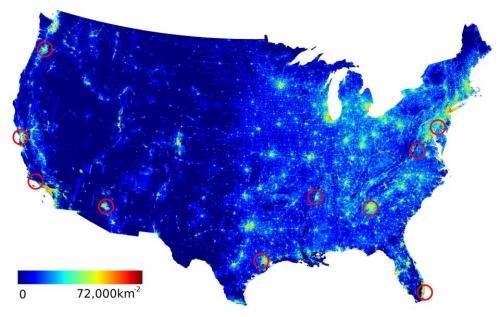April 2, 2013 report
Researchers root out the limits of social mobilization

(Phys.org) —A team of international researchers working together to better understand how social mobilization works, has built a model using data obtained by the DARPA Network Challenge in 2009. In their paper published in the Proceedings of the National Academy of Sciences, they say their results show that social mobilization only appears to be successful under optimum circumstances.
Social mobilization is a new phenomenon—it's where people connected together through social media such as Facebook and Twitter all strive to achieve a goal of some sort. One recent example was millions of people switching their Facebook profile picture to display a white "=" over a red background in support of same-sex marriage as the U.S. Supreme court was grappling with the issue recently. Other examples are people using social media to overthrow a government or to help find missing children.
But, because social mobilization is so new, relatively little is known about it, such as what conditions make for successful campaigns, and which don't. To find out, the diverse group of researchers looked to the DARPA Network Challenge which was held in 2009. There 10 weather balloons were hidden in various locations in the continental United States and a reward of $40,000 was offered to whoever found them all first. The team that won, from MIT, used a very coordinated social mobilization effort and located all ten balloons in less than nine hours. Another similar effort called the "Tag Challenge" was run by the U.S. Department of State and the U.S. Embassy in Prague last year. That challenge was won by an International team of researchers also using social mobilization. In this new effort, the researchers created simulations that best describe the conditions that exist when social mobilization efforts get underway. Tying all three efforts together is computer scientist Manuel Cebrian now at the University of California—he was on the winning team for both challenges and is a member of this new effort as well.

The researchers built simulations using data from the DARPA Challenge, adding in both demographic and geographic data and the strategy used by the team that won. They found that one of the critical factors to success was a central leader who not only had many social ties to begin with, but also was skillful at getting the word out very quickly. They also found what they call "small world" connections to be important—it's where a few core people who participate are scattered over large geographic areas. And finally, they note that finding the balloons also depended on the population density of the people looking for them and of course how much they stuck out in the area where they were "hidden." Thus, sometimes, they found, there are certain conditions unique to the challenge that can mean the difference between success and failure.
More information: Limits of social mobilization, PNAS, Published online before print April 1, 2013, doi: 10.1073/pnas.1216338110
Abstract
The Internet and social media have enabled the mobilization of large crowds to achieve time-critical feats, ranging from mapping crises in real time, to organizing mass rallies, to conducting search-and-rescue operations over large geographies. Despite significant success, selection bias may lead to inflated expectations of the efficacy of social mobilization for these tasks. What are the limits of social mobilization, and how reliable is it in operating at these limits? We build on recent results on the spatiotemporal structure of social and information networks to elucidate the constraints they pose on social mobilization. We use the DARPA Network Challenge as our working scenario, in which social media were used to locate 10 balloons across the United States. We conduct high-resolution simulations for referral-based crowdsourcing and obtain a statistical characterization of the population recruited, geography covered, and time to completion. Our results demonstrate that the outcome is plausible without the presence of mass media but lies at the limit of what time-critical social mobilization can achieve. Success relies critically on highly connected individuals willing to mobilize people in distant locations, overcoming the local trapping of diffusion in highly dense areas. However, even under these highly favorable conditions, the risk of unsuccessful search remains significant. These findings have implications for the design of better incentive schemes for social mobilization. They also call for caution in estimating the reliability of this capability.
Journal information: Proceedings of the National Academy of Sciences
© 2013 Phys.org




















